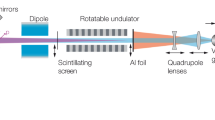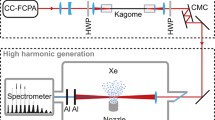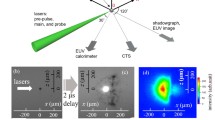Abstract
A laser-plasma source comprising a rotating cryogenic solid-state Xe target has been studied for use in extreme ultraviolet lithography (EUVL) systems equipped with La/B4C mirrors. The laser-to-EUV power conversion efficiency (CE) of the cryogenic Xe target was improved to achieve a maximum CE of 0.15 % at 6.7 nm with 0.6 % bandwidth. We successfully demonstrated the continuous generation of EUV light with an average power of 80 mW at 6.7 nm with 0.6 % bandwidth using a Nd:YAG slab laser at a repetition rate of 320 Hz and an average power of 100 W. Scaling-up of the laser-plasma source for use as a future EUVL source is also discussed.
Similar content being viewed by others
Avoid common mistakes on your manuscript.
1 Introduction
A laser-plasma X-ray (LPX) source, using radiation from high-energy-density plasma produced by high-peak power laser irradiation on a target, is expected for use in industrial applications, especially for use as an extreme ultraviolet lithography (EUVL) source for the industrial mass production of semiconductors. EUVL sources are typically required to emit light at a wavelength of 13.5 nm with a 2 % bandwidth. However, the wavelength of this light in such EUVL projection lithography systems is limited by the reflectivity of the Mo/Si mirrors used. We have previously studied the potential application of a Xe target that can emit 13 nm light for use in EUVL projection lithography systems [1]. The plasma debris, typically emitted from the plasma with EUV light irradiation, damage the mirrors and degrades their reflectivity. Because Xe is an inert gas, its chemically inactive debris vaporize instantly instead of depositing on mirrors near the plasma. On the other hand, a metal target such as Sn would deposit and remain on the mirrors, degrading their reflectivity in a short period. Therefore the use of Xe targets results in reducing the debris problem and we chose it. The Xe target was solidified to provide a higher laser-to-EUV power conversion efficiency (CE), owing to the higher density of the Xe target in the solid state compared to the gas state, and a smaller gas load to be evacuated by the exhaust pump system. Then, we developed a fast-rotating cryogenic drum system to provide a continuous supply of solid Xe at the laser focal point. The original emission from the Xe plasma has a broad spectrum in the range from 5 to 17 nm and its emission peak occurs at 10.8 nm, not 13.5 nm. Therefore, we could only use a tail portion of the Xe plasma emission spectrum to obtain the necessary light at 13.5 nm with 2 % bandwidth, not its emission peak. From this, improvements in the CE at 13.5 nm with 2 % bandwidth became the most critical issue for our Xe plasma source. To achieve a high CE, we controlled the condition parameters of the plasma and attempted to optimize them by changing the pumping laser conditions. At present, the maximum CE obtained is 0.9 % at 13.5 nm with 2 % bandwidth in the optimized condition, corresponding to a laser intensity of 1 × 1010 W/cm2.
Recently, a new lithography system that uses La/B4C mirrors having a reflectivity peak at 6.7 nm has been proposed as a next-generation candidate to supersede the current EUVL projection lithography system, which relies on Mo/Si mirrors having a reflectivity peak at 13.5 nm [2]. This means that a light source emitting around 6 nm will be required for use in future lithography systems for industrial mass production of semiconductors. To achieve a high CE around 6 nm, LPX sources based on targets of high-Z metal elements such as Gd and Tb, have been studied [3]. However, these LPX sources cannot be used effectively for industrial EUVL applications until a number of difficult problems have been resolved, including the high cost of the targets, establishing a way to continuously supply the targets, and the plasma debris problem associated with such metals, etc.
Here, we propose the use of our Xe LPX source as a 6 nm light source because it emits broadly in the 5–17 nm range as mentioned above and does not exhibit the problems highlighted above. In addition, previous studies to improve the CE of the LPX source at 13.5 nm have indicated that emissions around 6 nm become stronger at higher laser intensities. Thus, we next characterized the Xe LPX as a source, emitting at 6.7 nm with 0.6 % bandwidth required for use with La/B4C mirrors [4].
In this letter, we describe the characteristics of EUV at 6.7 nm using our present LPX source and discuss a scaling-up rule to achieve a higher power EUVL source for use in future lithography systems.
2 Experiment
Our LPX source uses the developed target system described in [5]. As shown in Fig. 1, the target system comprises a cylindrical drum having a copper surface, which is filled with liquid nitrogen to cryogenically cool the copper surface. Next, Xe gas is then blown onto the cryogenically cooled copper surface of the drum such that the gas condenses to form a solid Xe layer. The cylindrical drum is then rotated around its longitudinal z-axis, and is caused to move up and down along the z-axis during rotation in a spiral motion so that a fresh Xe target surface is supplied continuously for every laser shot. The diameter of the drum is 10 cm. Its mechanical rotation and up–down speed are tunable at 0–1200 rpm and 0–10 mm/s over a range of 3 cm, respectively. The target system further comprises wipers mounted adjacent to the drum at a set distance from the copper surface of the drum to maintain the solid Xe layer at a constant thickness, and to also collect any Xe target powder that deposits on the craters produced by laser irradiation, thereby increasing the recovery speed. In this respect, the rotating cryogenic drum system developed can supply a fresh Xe target surface continuously, upto a maximum repetition rate of 20 kHz with a laser energy of 1 J. Figure 2 shows an experimental setup to obtain data for the EUV emission from the cryogenically cooled rotating Xe target. Here, a conventional Q-switched Nd:YAG rod laser (Spectra-Physics, PRO-230) was used in single-shot operation, which could deliver pulses at wavelengths of 1 ω (1,064 nm), 2 ω (532 nm) and 3 ω (355 nm). The laser pulse width was about 10 ns. The pulses were expanded using a beam-expander and focused on the target with an f = 500 mm lens so that the plasma was produced and emitted EUV radiation. In the double-pulse irradiation experiments, another laser was prepared for delivering pre-pulses, which could deliver pulses at wavelengths of 1 ω with a pulse width of 20 ns. The pre-pulse and the main pulse were co-aligned and introduced to the focus lens with a time delay of 10–40 ns. By changing the position of the focus lens to change a laser spot, laser intensity on the target was adjusted to find an optimized intensity. To measure the generated EUV emission, we employed an energy detector calibrated at 13.5 nm with 2 % bandwidth (SCIENTEC Engineering, Flying Circus III) and a spectrometer having a resolution of 0.59 nm, which is equipped with a transmission grating (50 µm diameter and 1,000 line/mm) and a back-illuminated 2D-CCD camera. At first, the 13.5 nm light with 2 % bandwidth in the emission spectrum was calibrated using the energy detector. Next, the required 6.7 nm light with 0.6 % bandwidth in the emission spectrum was compared with the 13.5 nm light with 2 % bandwidth to obtain an absolute CE for the 6.7 nm light with 0.6 % bandwidth, taking into account the diffraction efficiency of the grating and the sensitivity of the CCD camera. To achieve the highest CE at 6.7 nm with 0.6 % bandwidth, we attempted to control the plasma parameter by changing the driving laser conditions. We investigated the dependence of the CE on the drum rotation, laser intensity, and laser wavelength, and also investigated the effect of double-pulse irradiation.
3 Results and discussion
Under certain operating conditions, humps around 6 nm were observed in the emission spectra (see Fig. 3). The emission spectra in Fig. 3 were obtained using a 1 ω pulse in the rotation and rest condition (a), a 3 ω pulse in the rest condition (b), and 1 ω double-pulse in the rest condition (c), respectively. In the rest condition, the Xe gas flow is stopped (0 mL/min) after the Xe target layer has formed on the cryogenically cooled copper surface of the drum, and the drum is rested (0 rpm) during each laser shot and then rotated stepwise after every shot so that a fresh target is supplied to the point irradiated by the laser. In the rotation condition, laser pulses irradiate quasi-continuously the target on the rotating drum (130 rpm), with Xe gas (40 mL/min) being supplied for forming the Xe target layer on the cryogenically cooled copper surface of the drum. In previous experiments for the EUV emission at 13.5 nm with 2 % bandwidth, we observed an increase in CE and a lower production of fast ions when the drum was rotated, as compared with conditions when the drum was at rest [6]. In the present study for the EUV emission at 6.7 nm, the same phenomena were observed as shown in Fig. 3a, i.e., a hump was observed at around 6 nm, which had a higher intensity in the EUV emission spectrum corresponding to the rotating drum, as compared with the EUV emission spectrum corresponding to the drum at rest. This result is explained by the following exploration discussed in [6]. The Xe gas vaporized on the target surface by the wipers during the rotation produces an optically thick plasma having an optimized density and a temperature suitable for emitting EUV radiation. We also explain that such long-scale (optically thick) plasma was produced by the shorter-wavelength (Fig. 3b) and the double-pulse irradiations (Fig. 3c) under the rest condition, and increased the EUV around 6 nm. As a result of this work, it was found that a maximum CE at 6.7 nm with 0.6 % bandwidth was obtained for the 1 ω laser irradiation and the rotating drum target (Fig. 3a), and its CE was estimated from this emission spectrum to be 0.15 %. The CE was spatially integrated taking into account its EUV angular distribution measured, which can be expressed by a fitting curve of (cos θ)0.67. Because the bandwidth of 0.6 % for the La/B4C mirror reflectivity is narrower than the 2 % for the Mo/Si mirror, the available reflected power is intrinsically small. In the case of 13.5 nm light, a maximum CE was also obtained for the 1ω laser irradiation and the rotating drum target, however, the laser intensity in this case was 1 × 1010 W/cm2 at a laser energy of 0.8 J. On the other hand, the maximum CE at 6.7 nm with 0.6 % bandwidth was obtained for the higher laser intensity of 4 × 1012 W/cm2 at a laser energy of 0.8 J. Because the Xe[XI] ion mainly emits 13.5 nm light and the Xe[XLIV] ion emits 6.7 nm light [7], it is considered that a higher laser intensity is required to achieve a higher charge state. Here, we roughly calculate the required laser intensity. Assuming that the plasma electron temperature, Te, is proportional to 1/3 power of the charge state, Z, and that Te is proportional to 2/3 power of the laser intensity, I [8], a dependence of the laser intensity I on the charge state, Z, can be written as: I ∝ Z 9/2. Using the optimized laser intensity of 1 × 1010 W/cm2 for the Xe[XI] ions, we estimated that the required laser intensity for the Xe[XLIV] ions emitting 6.7 nm was 7 × 1012 W/cm2. This estimated laser intensity is slightly higher than the tested maximum laser intensity of 4 × 1012 W/cm2 in this experiment that was limited using the laser oscillator. We consider that higher laser intensities may lead to higher CE in the future.
EUV radiation spectra with a hump at 6 nm emitted from the cryogenically cooled Xe drum target. The dotted lines represent 13.5 nm light with 2 % bandwidth and 6.7 nm light with 0.6 % bandwidth, respectively. a 1 ω pulse irradiation (0.8 J/10 ns) for both the rotating drum and the drum at rest. The laser intensity was 4 × 1012 W/cm2. b 3 ω pulse irradiation (0.25 J/8 ns) at rest. The laser intensity was 4 × 1010 W/cm2 [A], 8 × 1010 W/cm2 [B], 1.5 × 1011 W/cm2 [C] and 5 × 1011 W/cm2 [D], respectively. c 1 ω double-pulse irradiation (main 1 J/10 ns, pre 0.16 J/20 ns) with time delay (dt) at rest. The dt was changed from 0 to 40 ns and the optimum was found to be 28 ns. The laser intensity was 3 × 1011 W/cm2
Because CE is dependent on the laser intensity, a CE at 6.7 nm with 0.6 % bandwidth was estimated to be 0.08 % for a laser intensity of 1.5 × 1010 W/cm2 at a laser energy of 0.3 J. Therefore, when our developed slab laser having an average power of 100 W (0.3 J at 320 Hz) [9] was used to irradiate the rotating target, a continuous EUV generation was achieved with an average power of 80 mW at 6.7 nm with 0.6 % bandwidth. Though the obtained power is still low, our source is the only LPX source at present that can generate an emission continuously at 6.7 nm.
However, the EUV power required for the industrial mass production of semiconductors is more than 100 W at present; our power is three orders of magnitude less. To approach the requirements of an industrial EUV source, the power of our source is required to be scaled up. From the above results, an EUV power of 120 W at 6.7 nm with 0.6 % bandwidth can be obtained if a pumping laser power achieves 0.8 J × 100 kHz = 80 kW. Though the present drum system was designed to supply Xe targets for laser pulses with a maximum repetition rate of 20 kHz and an energy of 1 J, a repetition rate up to 100 kHz may be possible by enlarging the drum diameter from the present 10 cm to 50 cm corresponding with our design rule [5]. The previous work [10] indicated that the majority of Xe plasma debris was fast ions, which can be mitigated relatively easily using gas and/or a magnetic/electric field. The problem of plasma debris will not be critical for our LPX source, nor will the cost of the target as the Xe gas can be recycled using a recycling system. From these, we conclude that our LPX source has less critical issues and the power of our LPX source can be scaled up easily when compared with those sources using high-Z metal targets. However, one remaining issue that needs to be addressed relates to the powering up of the driving laser. The maximum CE achieved in this work was 0.15 % at 6.7 nm with 0.6 % bandwidth and it has not yet reached the 0.54 and 0.33 % at 6.7 nm with 0.6 % bandwidth for a low-density and solid-density Gd target, respectively [11]. To reduce the pump laser power, it will be necessary to make improvements to the Xe target to achieve higher CE.
4 Conclusion
An EUV light source using a rotating cryogenic Xe target was characterized at a wavelength of 6.7 nm with 0.6 % bandwidth. In this work, the maximum CE was found to be 0.15 % at 6.7 nm with 0.6 % bandwidth. When a slab laser having a repetition pulse of 320 Hz and an average power of 100 W irradiated the rotating target, continuous EUV generation was achieved with an average power of 80 mW at 6.7 nm with 0.6 % bandwidth. And it has been shown that achieving EUV power of 100 W-class at 6.7 nm with 0.6 % bandwidth is not impossible if the pump laser power is increased. At present, our laser plasma X-ray (LPX) source having an Xe target is the only source that can continuously generate EUV around 6 nm, and demonstrate a scaling-up rule toward achieving a future industrial EUVL source.
References
S. Amano, Laser-plasma extreme ultraviolet source incorporating a cryogenic Xe target, in Recent advances in nanofabrication techniques and applications, ed. by B. Cui (InTech, Croatia, 2011), pp. 353–368
J. Benschop, in EUV: past, present and prospects, Keynote I, 2009 International Symposium on Extreme Ultraviolet Lithography, International Sematech, Prague Czech, October 2009, http://www.sematech.org/meetings/archives/litho/index.htm
T. Otsuka, D. Kilbane, J. White, T. Higashiguchi, N. Yugami, T. Yatagai, W. Jiang, A. Endo, P. Dunne, and G. O`Sullivan: Appl. Phys. Lett. 97, 111503 (2010)
V. Banine, A. Yakunin, and D. Glushkov, in Next generation EUV lithography: challenges and Opportunities, 2010 International Workshop on EUV Sources, EUV LITHO, INC., Dublin, November 2010, http://www.euvlitho.com/index.html
K. Fukugaki, S. Amano, A. Shimoura, T. Inoue, S. Miyamoto, T. Mochizuki, Rev. Sci. Instrum. 77, 063114 (2006)
S. Amano, K. Masuda, A. Shimoura, S. Miyamoto, T. Mochizuki, Appl. Phys. B. 101, 213–219 (2010)
S. Amano, T. Mochizuki, IEEE J. Quantum Electron. QE37, 296 (2001)
E. Saloman, J. Phys. Chem. Ref. Data 33, 765–921 (2004)
D. Colombant, G.F. Tonon, J. Appl. Phys 44, 3524 (1973)
S. Amano, Y. Inaoka, H. Hiraishi, S. Miyamoto, T. Mochizuki, Rev. Sci. Instrum. 81, 023104 (2010)
T. Higashiguchi, T. Otsuka, N. Yugami, T. Yatagai, W. Jiang, A. Endo, B. Li, D. Kilbane, P. Dunne, G. O`Sullivan, Appl. Phys. Lett. 99, 191502 (2011)
Author information
Authors and Affiliations
Corresponding author
Rights and permissions
About this article
Cite this article
Amano, S., Inoue, T. Laser-plasma extreme ultraviolet source at 6.7 nm using a rotating cryogenic Xe target. Appl. Phys. B 108, 743–747 (2012). https://doi.org/10.1007/s00340-012-5215-2
Received:
Revised:
Published:
Issue Date:
DOI: https://doi.org/10.1007/s00340-012-5215-2







